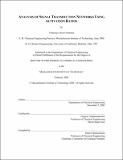Analysis of signal transduction networking using activation ratios
Author(s)
Femenia, Francisco J
DownloadFull printable version (3.309Mb)
Other Contributors
Massachusetts Institute of Technology. Dept. of Chemical Engineering.
Advisor
Gregory Stephanopoulos.
Terms of use
Metadata
Show full item recordAbstract
The molecular processes by which information is incorporated and distributed within a cell are termed signal transduction. These pathways allow cells to interact with each other and with their environments and are critical to the proper cellular function in a variety of contexts. Previously developed methods for analyzing signaling networks have been largely ignored, most likely due to their mathematical complexity and difficulty in application. A novel analysis framework was developed to assist in the examination of signaling networks, both to facilitate the reconstruction of previously undetermined pathways as well as to quantitatively characterize interactions between components. This approach, termed activation ratio analysis, involves the ratio between active and inactive forms of signaling intermediates at steady state. The activation ratio of an intermediate is shown to depend linearly upon the concentration of the activating enzyme. The slope of the line is defined as the activation factor, and is determined by the kinetic parameters of activation and inactivation. The mathematical functionality of the activation ratio changes for other signaling network arrangements. It is therefore possible to extract the original network structure from a set of measured activation ratios, with activation factors yielding a measure of activation potential between intermediates. This framework was tested using computational simulations of a small-scale interconnected network, cascades with feedback, and in the presence of experimental noise. In the process, additional tools were developed to automate and evaluate the analysis. (cont.) The theoretical concepts were also applied to examine the modification cycles of the protein Erk2 by the kinase Mekl and phosphatases PTP1B and PP2A in vitro. Limitations in the accuracy of measurements and experimental setup resulted in high uncertainty in the calculated distribution of Erk states, preventing a quantitative analysis of this system. Nevertheless, qualitative predictions from activation ratio analysis were verified, in particular, the influence of component concentrations on the Erk distribution at steady state. While these issues indicate considerations for future experimental studies, they do not override the ability of activation ratio analysis to investigate signaling networks, where description of interactions in the whole system is more important than detailed examination of the individual steps.
Description
Thesis (Ph. D.)--Massachusetts Institute of Technology, Dept. of Chemical Engineering, 2004. Includes bibliographical references. This electronic version was submitted by the student author. The certified thesis is available in the Institute Archives and Special Collections.
Date issued
2004Department
Massachusetts Institute of Technology. Department of Chemical EngineeringPublisher
Massachusetts Institute of Technology
Keywords
Chemical Engineering.